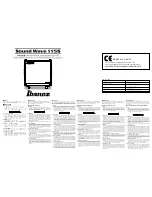
gerung sowie Klangverbesserung wird ein Power-
Kondensator empfohlen (z. B. CAP-…*).
6.1.2 Masseanschluss
Den Masseanschluss GND (19) über ein Kabel mit
einem Querschnitt von mindestens 20 mm
2
(z. B.
CPC-200/SW*) mit der Masse des Autos oder bes-
ser direkt mit der Minusklemme der Autobatterie ver-
binden.
Hinweise:
1. Bei Verwendung der Karosserie als Massean-
schluss muss die verwendete Stelle einen guten
elektrischen Kontakt zur Hauptkarosserie aufwei-
sen (z. B. durch ausreichend viele Schweiß-
punkte). Eventuell vorhandener Lack am Kon-
taktpunkt muss vollständig entfernt werden.
2. Zur Vermeidung von Masseschleifen muss die
Masse des Autoradios an die Stelle gelegt wer-
den, an der auch die Endstufe an Masse liegt.
6.1.3 Steuerspannung zum Einschalten
Die Car-HiFi-Endstufe wird durch eine Steuerspan-
nung von +12 V am Anschluss REM (20) ein- und
ausgeschaltet. Den Anschluss REM mit dem 12-V-
Schaltausgang vom Autoradio verbinden (Anschluss
für eine Motorantenne, eventuell mit der Motoran-
tenne parallel schalten).
6.2 Eingänge
Die Line-Eingänge (3) der Endstufe werden über
Cinch-Kabel mit den Line-Ausgängen des Auto-
radios (oder einer anderen Signalquelle) verbunden.
Sind am Autoradio jedoch keine Line-Ausgänge vor-
handen, können die Lautsprecherausgänge des
Autoradios über einen Audio-Übertrager (z. B. FGA-
22HQ*) mit den Line-Eingängen der Endstufe ver-
bunden werden. Der genaue Anschluss richtet sich
nach der gewünschten Betriebsart der Endstufe:
6.2.1 4-Kanalbetrieb
(Abb. 3)
Der 4-Kanalbetrieb wird beim Einsatz von vier Full-
Range-Lautsprechern (2- oder 3-Wege-Lautspre-
cher) benötigt. Die Line-Ausgänge des Autoradios
wie folgt mit den Eingängen LINE IN (3) verbinden:
Front links
auf Kanal 1
Front rechts
auf Kanal 2
Rear links
auf Kanal 3
Rear rechts
auf Kanal 4
Sind am Autoradio keine Ausgänge für die hinteren
Kanäle (Rear) vorhanden, den Ausgang des linken
Kanals über ein Y-Kabel (z. B. CBA-25/SW*) mit
den Eingängen der Kanäle 1 und 3 verbinden und
den Ausgang des rechten Kanals über ein weiteres
Y-Kabel mit den Eingängen der Kanäle 2 und 4 (wie
in Abb. 4 dargestellt).
6.2.2 Aktiver 2-Wegebetrieb
(Abb. 4)
Beim aktiven 2-Wegebetrieb mit Mittelhochtönern
und (Kick-)Basslautsprechern wird jeder Lautspre-
cher von einem eigenen Verstärkerkanal angetrie-
ben. Die Line-Ausgänge des Autoradios wie folgt mit
den Eingängen LINE IN (3) verbinden:
Den Ausgang des linken Kanals über ein Y-Kabel
(z. B. CBA-25/SW*) mit den Eingängen der Kanäle
1 und 3 verbinden und
den Ausgang des rechten Kanals über ein weiteres
Y-Kabel mit den Eingängen der Kanäle 2 und 4.
6.2.3 Brückenbetrieb
(Abb. 5)
Zur Erhöhung der Ausgangsleistung können die
Kanäle 1 und 2 in Brückenschaltung den linken
Lautsprecher antreiben sowie die Kanäle 3 und 4 in
Brückenschaltung den rechten Lautsprecher. Die
Line-Ausgänge des Autoradios wie folgt mit den Ein-
gängen LINE IN (3) verbinden:
Den Ausgang des linken Kanals über ein Y-Kabel
(z. B. CBA-25/SW*) mit den Eingängen der Kanäle
1 und 2 verbinden und
den Ausgang des rechten Kanals über ein weiteres
Y-Kabel mit den Eingängen der Kanäle 3 und 4.
6.2.4 3-Kanalbetrieb
(Abb. 6)
Der 3-Kanalbetrieb dient zur Unterstützung von zwei
Full-Range-Lautsprechern durch einen Subwoofer.
Um für den Subwoofer eine höhere Leistung zu er-
halten, werden zwei Kanäle in Brücke geschaltet.
Die Ausgänge des Autoradios wie folgt mit den Ein-
gängen LINE IN (3) verbinden:
linker Kanal
auf Kanal 1
rechter Kanal auf Kanal 2
Subwoofer L auf Kanal 3
Subwoofer R auf Kanal 4
Sind am Autoradio keine Ausgänge für einen Sub-
woofer-Verstärker vorhanden, den Ausgang des lin-
ken Kanals über ein Y-Kabel (z. B. CBA-25/SW*) mit
den Eingängen der Kanäle 1 und 3 verbinden und
den Ausgang des rechten Kanals über ein weiteres
Y-Kabel mit den Eingängen der Kanäle 2 und 4 (wie
in Abb. 6 dargestellt).
6.3 Line-Ausgänge für weitere Endstufen
Sollen weitere Endstufen in die Car-HiFi-Anlage ein-
gesetzt werden, können deren Eingänge an die
Buchsen LINE OUT (14) angeschlossen werden. An
diesen Buchsen liegen die Signale der Eingangs-
buchsen (3) an.
6.4 Lautsprecher
Es lassen sich Full-Range-Lautsprecher (2- oder 3-
Wege-Lautsprecher), Mittelhochtöner, Basslautspre-
cher oder Subwoofer betreiben.
Wichtig!
Alle Lautsprecher müssen 2-polig angeschlossen
werden, d. h. ohne gemeinsamen Masseanschluss.
Bei der Auswahl geeigneter Lautsprecher unbe-
dingt deren mechanische und elektrische Belast-
barkeit im Zusammenhang mit der genutzten
Endstufenleistung berücksichtigen (siehe auch
technische Daten der Endstufe auf Seite 9).
sound improvement, a power capacitor is recom-
mended (e. g. CAP-...*).
6.1.2 Ground connection
Connect the ground terminal GND (19) via a cable
with a minimum cross section of 20 mm
2
(e. g.
CPC-200/SW*) to the ground of the car or better
directly to the negative terminal of the car battery.
Notes:
1. When using the chassis as a ground connection,
the place used must have a good electrical
contact to the main chassis (e. g. by a sufficient
number of welding points). Any lacquer at the
point of contact must completely be removed.
2. To prevent ground loops, the ground of the car
radio must be applied at the place where also the
power amplifier is grounded.
6.1.3 Control voltage for switching-on
The car HiFi power amplifier is switched on and off
by a control voltage of +12 V at the terminal REM
(20). Connect the terminal REM to the 12 V control
output of the car radio (connection for a motor
antenna, if necessary, to be connected in parallel to
the motor antenna).
6.2 Inputs
The line inputs (3) of the power amplifier are
connected via cables with phono connectors to the
line outputs at the car radio (or another signal
source). However, if the car radio is not equipped
with line outputs, the speaker outputs of the car
radio can be connected via an audio transformer
(e. g. FGA-22HQ*) to the line inputs of the power
amplifier. The exact connection depends on the
desired operating mode of the power amplifier:
6.2.1 4-channel operation
(fig. 3)
The 4-channel operation is required when using four
full range speakers (2-way or 3-way speakers).
Connect the line outputs of the car radio to the
inputs LINE IN (3) as follows:
front left
to channel 1
front right to channel 2
rear left
to channel 3
rear right to channel 4
If the car radio is not equipped with outputs for the
rear channels, connect the output of the left channel
via a Y cable (e. g. CBA-25/SW*) to the inputs of
channels 1 and 3 and the output of the right channel
via another Y cable to the inputs of channels 2 and 4
(as shown in fig. 4).
6.2.2 Active 2-way operation
(fig. 4)
For active 2-way operation with mid-high range
speakers and (kick) bass speakers, each speaker is
driven by an individual amplifier channel. Connect
the line outputs of the car radio to the inputs LINE IN
(3) as follows:
Connect the output of the left channel via a Y cable
(e. g. CBA-25/SW*) to the inputs of channels 1 and
3 and
the output of the right channel via another Y cable to
the inputs of channels 2 and 4.
6.2.3 Bridge operation
(fig. 5)
To increase the output power, channels 1 and 2 in
bridge operation may drive the left speaker and
channels 3 and 4 in bridge operation the right
speaker. Connect the line outputs of the car radio to
the inputs LINE IN (3) as follows:
Connect the output of the left channel via a Y cable
(e. g. CBA-25/SW*) to the inputs of channels 1 and
2 and
the output of the right channel via another Y cable to
the inputs of channels 3 and 4.
6.2.4 3-channel operation
(fig. 6)
The 3-channel operation serves to support two full
range speakers by a subwoofer. To obtain a higher
power for the subwoofer, two channels are used in
bridge circuit. Connect the outputs of the car radio to
the inputs LINE IN (3) as follows:
left channel
to channel 1
right channel to channel 2
subwoofer L to channel 3
subwoofer R to channel 4
If the car radio is not equipped with outputs for a
subwoofer amplifier, connect the output of the left
channel via a Y cable (e. g. CBA-25/SW*) to the
inputs of channels 1 and 3 and the output of the right
channel via another Y cable to the inputs of chan-
nels 2 and 4 (as shown in fig. 6).
6.3 Line outputs for further power amplifiers
If further power amplifiers are additionally to be
inserted into the car HiFi system, their inputs may be
connected to the jacks LINE OUT (14). The signals
of the input jacks (3) are available at these jacks.
6.4 Speakers
It is possible to use full range speakers (2-way or
3-way speakers), mid-high range speakers, bass
speakers, or subwoofers.
Important!
All speakers must be connected with 2 poles, i. e.
without common ground connection.
When choosing suitable speakers, pay in any case
attention to their mechanical and electrical capa-
bility in connection with the power used of the
power amplifier (also see specifications of the
power amplifier on page 9).
6
GB
D
A
CH
* von CARPOWER
* by CARPOWER




























